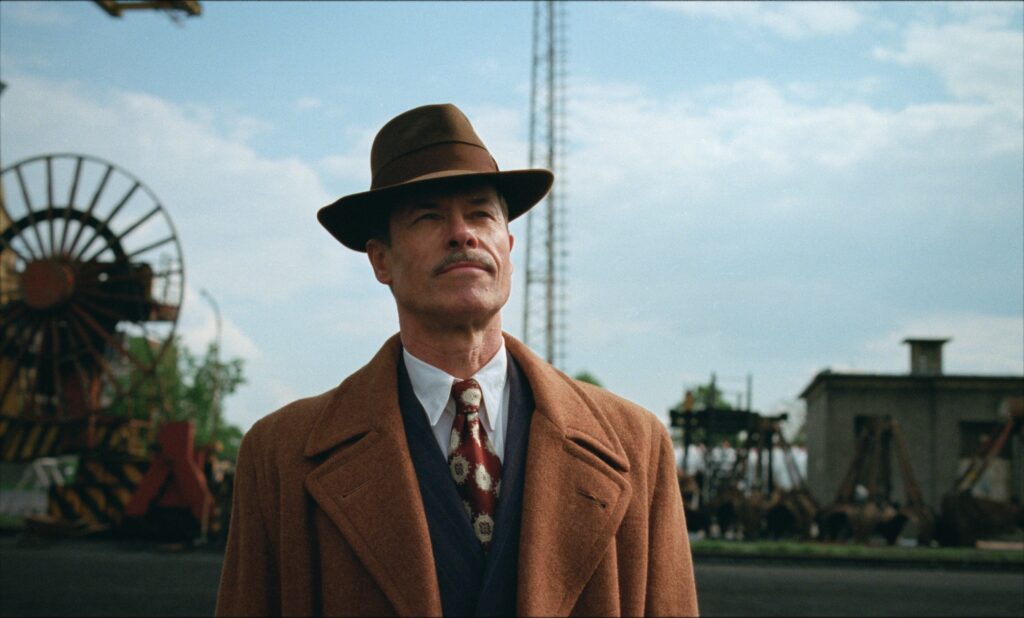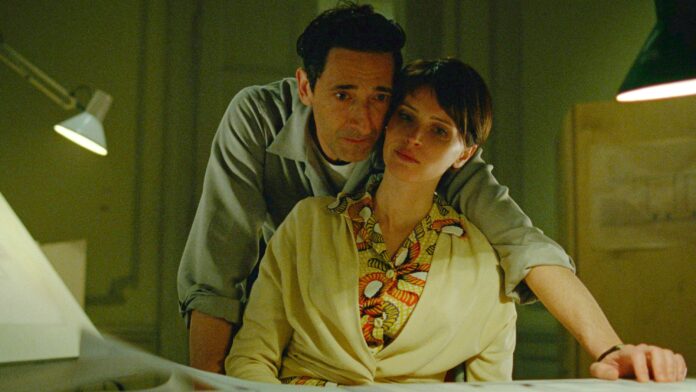The idea for The Brutalist, Brady Corbet’s epic drama depicting the life of an immigrant architect’s life in post-World War II America, began with what would become the film’s central relationship between Holocaust survivor László Tóth (Adrien Brody) and industrialist Harrison Lee Van Buren (Guy Pearce). That meeting of an artist and his patron, particularly an artist who escapes European fascism only to encounter American capitalism, ignited the imaginations of Corbet and his life and screenwriting partner Mona Fastvold.
“We were both interested in the time period, and it seemed like a natural epoch to explore for us,” Fastvold said during a recent trip to San Francisco. “Those were the early thoughts and ideas that we wanted to dig into. And then we both had a fascination for Brutalism. It has such an interesting history and a rich history, and a lot of the Brutalist architects in America of that time period were Jewish. So that just naturally led us to that journey.”
The resulting film is one of the most acclaimed of the year, the winner of four awards at the Venice Film Festival and a probable multiple Oscar nominee. Clocking in at 3 ½ hours, the drama includes an intermission that Fastvold and Corbet wrote into their screenplay. In many ways, the drama is a throwback to the midcentury time period in which it is largely set, right down to the VistaVision employed by cinematographer Lol Crawley. The widescreen 35mm film format introduced with 1954’s White Christmas and that Hitchcock used for Vertigo was pioneered by Paramount but largely abandoned by the 1960s but equipment still exists.
“From the beginning of my collaboration with Brady on this film, he used words like archival and patchwork and things like this in terms of the aesthetic itself, having different formats embedded in it because there’s also some 16mm, and at the end of the movie there’s some low-end digital kind of 1980s cameras, things like that,” Crawley says. “So, the idea of VistaVision intrigued Brady. If so much of the movie takes place at that time, try and use a camera system that will capture that.
“This is the third film I’ve shot for Brady, and they’ve always been on film,” Crawley adds. “And I think it’s like Brady’s just really run to the finish line with this one in terms of the idea of a theatrical release, really celebrating the idea of a theatrical release with this format.”
Tóth and Van Buren’s relationship develops over a period of years, much of it revolving around the major commission the tycoon bestows on the architect to build a community center. Over the years, the building and the challenges faced in its construction bring the men together and pull them apart with Tóth confident in his designs and Van Buren with the oligarch’s need to always assert his power.
With so much in play within the world of The Brutalist—a furniture store belonging to Tóth’s cousin Attila (Alessandro Nivola) where Tóth works when he first comes to America, Van Buren’s mansion, the ever-changing community center, a tiny New York apartment where Tóth lives with his family, and more—the film was a dream for production designer Judy Becker who got to involve the full range of her creativity in designing the various environments but within a strict budget. She gives an example of Attila’s furniture store, a place chockablock with staid living room and bedroom sets, and décor like Santa Claus candlesticks.

“I tried to embody László in a sense, and then I wanted to contrast him with Attila’s assimilation into America and American middle-class culture,” Becker says. “One of the things I knew when we started pre-production that was going to be in Hungary is that I wanted this very classic traditional colonial furniture in the furniture store because Attila wants to be American and leave all of Europe behind him, which is understandable.
“So, we had a set decorator from Canada that I had worked with many times, and she shopped all of that furniture. It was very cheap. I mean, she probably spent a few hundred dollars on that furniture in total. And we filled a container with it and with some other really American stuff that you can’t find in Hungary or anywhere in Europe. And we shipped it to Hungary. And that was one of the more expensive things that we did on the movies. That was a place where we decided to spend a little chunk of our budget.”
The critics have chimed in their approval of The Brutalist, but will the public buy it or find that length daunting? The question frustrates Fastvold who observes that people will binge an entire season of a streaming show but then balk at the runtime of movies.
“The Brutalist is a whole life,” Crawley says. “This is a callback to midcentury filmmaking. It’s Gone with the Wind.”
Adds Fastvold, “A film is so expensive to make, it takes so many people to make it, so to just reduce it to that thing that you’re supposed to enjoy on your phone, that’s worst-case scenario, that is pretty depressing. So, make filmgoing an event again.“





